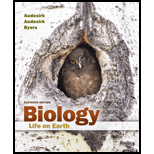
Concept explainers
Whale skeletons contain nonfunctional pelvic bones
a. as a result of convergent evolution.
b. due to catastrophism.
c. because whales evolved from ancestors that had hind legs.
d. because the bones might be needed for a future adaptation.
Introduction:
The vestigial can be referred to a rudimentary structure present in the body of an organism, which does not have any prominent function. These structures were functional in the ancestors of the organism, but during the course of evolution, the organism loses its function.
Answer to Problem 1MC
Correct answer:
The pelvic bone in the whales is a vestigial organ, which had a function in their ancestors, having hind limbs.
Explanation of Solution
Explanation for the correct answer:
Option (c) is given that the nonfunctional pelvic bones are present in whale’s skeleton as whales evolved from the ancestors that had hind legs. The whales are known to evolve from the Pakicetus. These organisms had four legs, and the hind limbs were functional. During the evolution, the hind limbs were lost, but the pelvic bone is still present in the whales. Hence, option (c) is correct.
Explanation for the incorrect answers:
Option (a) is given that the nonfunctional pelvic bones are present in whale’s skeleton as a result of convergent evolution. The convergent evolution can be defined as the process, in which the closely related species independently evolve the similar structures or traits to adapt to the environment. However, the pelvic bones were present in the ancestor of the whales, this is not evolved. So, it is an incorrect option.
Option (b) is that the nonfunctional pelvic bones are present in whale’s skeleton due to catastrophism. The catastrophism referred to a change, which occurs suddenly in the organism. However, the pelvic bones are not suddenly developed in the whales, it is not an example of catastrophism. So, it is an incorrect option.
Option (d) is because that the nonfunctional pelvic bones are present in whale’s skeleton might be needed for a future adaptation. The bones of the pelvis were functional in the ancestors of the whales. This is not evolved for the future adaptation. So, it is an incorrect option.
Hence, options, (a), (b), and (d) are incorrect.
Thus, it can be concluded that pelvic bones are a vestigial organ in whales. These were functional in their ancestors, but in whales, they are nonfunctional.
Want to see more full solutions like this?
Chapter 15 Solutions
Biology: Life on Earth (11th Edition)
- What is the opening indicated by the pointer? (leaf x.s.) stomate guard cell lenticel intercellular space none of thesearrow_forwardIdentify the indicated tissue? (stem x.s.) parenchyma collenchyma sclerenchyma ○ xylem ○ phloem none of thesearrow_forwardWhere did this structure originate from? (Salix branch root) epidermis cortex endodermis pericycle vascular cylinderarrow_forward
- Identify the indicated tissue. (Tilia stem x.s.) parenchyma collenchyma sclerenchyma xylem phloem none of thesearrow_forwardIdentify the indicated structure. (Cucurbita stem l.s.) pit lenticel stomate tendril none of thesearrow_forwardIdentify the specific cell? (Zebrina leaf peel) vessel element sieve element companion cell tracheid guard cell subsidiary cell none of thesearrow_forward
- What type of cells flank the opening on either side? (leaf x.s.) vessel elements sieve elements companion cells tracheids guard cells none of thesearrow_forwardWhat specific cell is indicated. (Cucurbita stem I.s.) vessel element sieve element O companion cell tracheid guard cell none of thesearrow_forwardWhat specific cell is indicated? (Aristolochia stem x.s.) vessel element sieve element ○ companion cell O O O O O tracheid O guard cell none of thesearrow_forward
- Identify the tissue. parenchyma collenchyma sclerenchyma ○ xylem O phloem O none of thesearrow_forwardPlease answer q3arrow_forwardRespond to the following in a minimum of 175 words: How might CRISPR-Cas 9 be used in research or, eventually, therapeutically in patients? What are some potential ethical issues associated with using this technology? Do the advantages of using this technology outweigh the disadvantages (or vice versa)? Explain your position.arrow_forward
 Concepts of BiologyBiologyISBN:9781938168116Author:Samantha Fowler, Rebecca Roush, James WisePublisher:OpenStax College
Concepts of BiologyBiologyISBN:9781938168116Author:Samantha Fowler, Rebecca Roush, James WisePublisher:OpenStax College Biology: The Dynamic Science (MindTap Course List)BiologyISBN:9781305389892Author:Peter J. Russell, Paul E. Hertz, Beverly McMillanPublisher:Cengage Learning
Biology: The Dynamic Science (MindTap Course List)BiologyISBN:9781305389892Author:Peter J. Russell, Paul E. Hertz, Beverly McMillanPublisher:Cengage Learning
 Comprehensive Medical Assisting: Administrative a...NursingISBN:9781305964792Author:Wilburta Q. Lindh, Carol D. Tamparo, Barbara M. Dahl, Julie Morris, Cindy CorreaPublisher:Cengage Learning
Comprehensive Medical Assisting: Administrative a...NursingISBN:9781305964792Author:Wilburta Q. Lindh, Carol D. Tamparo, Barbara M. Dahl, Julie Morris, Cindy CorreaPublisher:Cengage Learning Biology (MindTap Course List)BiologyISBN:9781337392938Author:Eldra Solomon, Charles Martin, Diana W. Martin, Linda R. BergPublisher:Cengage Learning
Biology (MindTap Course List)BiologyISBN:9781337392938Author:Eldra Solomon, Charles Martin, Diana W. Martin, Linda R. BergPublisher:Cengage Learning Human Biology (MindTap Course List)BiologyISBN:9781305112100Author:Cecie Starr, Beverly McMillanPublisher:Cengage Learning
Human Biology (MindTap Course List)BiologyISBN:9781305112100Author:Cecie Starr, Beverly McMillanPublisher:Cengage Learning





